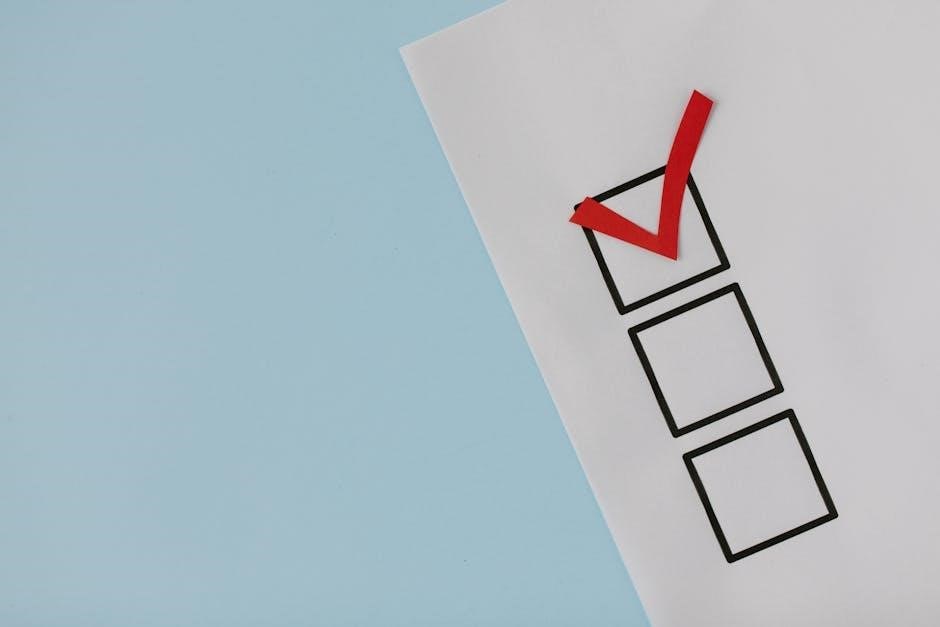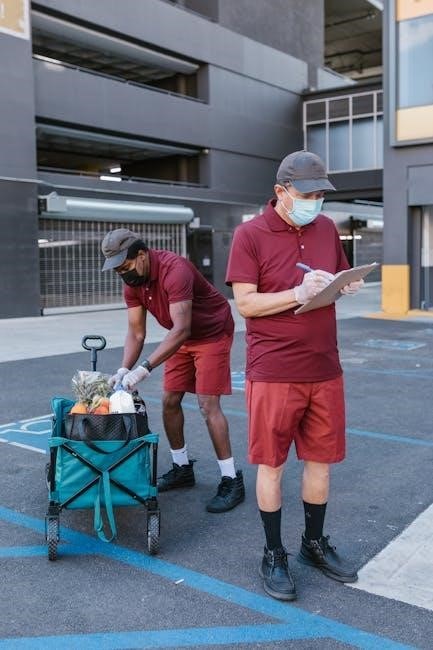A comprehensive used RV inspection checklist is crucial for ensuring a secure purchase․ It covers exterior, interior, and system evaluations, helping buyers avoid costly surprises․ Always include a road test․

Exterior Inspection
Inspect the tires for wear and damage, check exterior surfaces for dents or rust, and ensure all doors and windows function properly․ Examine the roof and seals for leaks․
Visual Inspection of Exterior Surfaces
Begin with a thorough visual inspection of the RV’s exterior surfaces․ Check for any signs of dents, scratches, or rust on the metal panels․ Inspect the paint finish for fading or unevenness, which could indicate aging or poor maintenance․ Look closely at the seams and joints for gaps or cracks, as these can be entry points for water․ Ensure all exterior trim is securely attached and in good condition․ Also, examine the windows and doors for any signs of damage or wear․ Pay particular attention to the roof, checking for cracks, tears, or areas of delamination that might compromise the RV’s structural integrity․
Tires and Wheels Condition
Inspect the tires for signs of uneven wear, cracks in the sidewalls, or excessive tread wear․ Ensure the tire pressure matches the manufacturer’s recommendations․ Check the spare tire and verify that it is in usable condition․ Look for any signs of damage or rust on the wheels and ensure they are securely attached․ Test the wheel bearings for any unusual noise or play․ Make sure all lug nuts are properly tightened and show no signs of stripping․ If the RV has a tag axle or dual wheels, inspect these areas carefully for alignment and condition․ A road test can also help identify any issues with tire performance, such as vibrations or pulling to one side․
Exterior Systems and Components
Inspect the seals and caulking around windows, doors, and joints for any signs of cracking or separation․ Check the propane system, including the tank, hoses, and connections, for leaks or damage․ Test the generator to ensure it operates smoothly and quietly․ Examine the roof vents and awning for proper function and condition․ Verify that all exterior lights, including brake lights and turn signals, are working correctly․ Inspect the propane tank for rust or dents and ensure the LP detector is functioning․ Check the exterior storage compartments for signs of water intrusion or damage․ Test the slide-outs to ensure they extend and retract smoothly․ Finally, evaluate the hitch and tow bar for wear or damage, ensuring they are securely attached and functioning properly․

Interior Inspection
Check for stains, odors, or water damage on ceilings and walls․ Ensure all interior doors and windows function properly and are free from cracks․ Verify lighting and fans work correctly, and inspect storage compartments for damage or pests․ Look for mold or mildew, especially in bathrooms and kitchens, and ensure all appliances are in good condition․ Test heating and cooling systems to confirm they operate efficiently․ Examine flooring for any signs of wear, water damage, or loose sections․ Ensure cabinets and countertops are secure and undamaged․ Check furniture and upholstery for stains or tears․ Verify that all interior locks are functioning and that smoke and carbon monoxide detectors are present and operational․ A thorough interior inspection ensures a comfortable and safe living space․
General Interior Condition
When evaluating the general interior condition of a used RV, look for signs of wear and tear, such as stains, odors, or water damage on walls, ceilings, and floors․ Check for mold or mildew, particularly in areas prone to moisture, like bathrooms and kitchens․ Ensure all interior doors and windows open and close smoothly, with no cracks or broken seals․ Inspect lighting and fans to confirm they are functioning properly․ Examine storage compartments for damage or pests․ Test heating and cooling systems to ensure they operate efficiently․ Verify that furniture and upholstery are free from stains or tears․ Check cabinets and countertops for stability and damage․ Ensure flooring is secure, with no signs of water damage or loosening․ Also, confirm that interior locks are working and that smoke and carbon monoxide detectors are present and functional․ A thorough assessment of these elements provides a clear picture of the RV’s overall interior condition and helps identify potential issues before purchase․
Kitchen and Bathroom Appliances

Inspect kitchen appliances such as the microwave, stove, and refrigerator to ensure they function properly․ Check for signs of wear or damage, and verify that all controls and lighting work․ Test the refrigerator’s cooling performance and ensure the stove burners and oven operate efficiently․ In the bathroom, examine the toilet for proper flushing and sealing․ Check the shower and sink for leaks or water damage, and ensure the faucets are in good condition․ Test the water heater to confirm it provides sufficient hot water․ Additionally, inspect kitchen and bathroom cabinets for damage or pest infestation․ Ensure all appliances are clean and free from mold or mildew․ Properly functioning kitchen and bathroom systems are essential for a comfortable RV experience․
Interior Safety Features
When inspecting the interior of a used RV, it is essential to evaluate its safety features․ Check that smoke and carbon monoxide detectors are present, functional, and have working batteries․ Ensure emergency exits are accessible and functioning properly․ Inspect the fire extinguisher to confirm it is present, easily accessible, and that the pressure gauge indicates it is fully charged․ Verify that all interior lighting, including emergency lights, is in good working condition․ Additionally, check for secure storage compartments to prevent items from shifting during travel․ Ensure proper ventilation by testing ceiling fans and vents to prevent moisture buildup and reduce the risk of mold․ These checks are vital to ensure a safe and secure living environment within the RV․
Plumbing System Inspection
Inspect the plumbing system for leaks, water damage, and functionality․ Check water tanks, connections, and fixtures․ Test water pump and ensure proper drainage․ Verify all systems operate efficiently․
Water Tanks and Connections
Inspect the freshwater, gray, and black water tanks for cracks, damage, or corrosion․ Ensure all connections, hoses, and valves are secure and free from leaks․ Check for signs of water damage or mineral buildup around fittings․ Test the water pump to ensure proper function and adequate pressure․ Verify that drain valves operate smoothly and that there are no obstructions in the lines․ Look for any signs of wear or deterioration in the hoses and connections, which could indicate potential failures․ Make sure all seals are intact to prevent leaks during travel or when in use․ Additionally, check the age and condition of the tanks and hoses, as older components may need replacement․ Finally, run water through the system to identify any hidden issues during operation․
Plumbing Fixtures and Leaks
Inspect all plumbing fixtures, including faucets, toilets, and showers, for proper function and leaks․ Check under sinks, around shower pans, and behind toilets for water damage or staining․ Test water pressure by turning on faucets and checking for consistent flow․ Look for mineral buildup or corrosion on fixtures, which may indicate hard water issues or aging components․ Verify that all drain lines are clear and functioning properly, with no signs of blockages or slow drainage․ Inspect the water heater for leaks, rust, or damage, and ensure it is securely mounted․ Check the condition and age of hoses and connections, as older parts may need replacement․ Finally, ensure the plumbing system holds pressure when tested and that all fixtures are securely installed to prevent movement during travel․
Electrical System Inspection
Inspect circuit breakers, outlets, and wiring for damage or wear․ Ensure all systems function properly, including lights, appliances, and GFCI protection in wet areas like kitchens and bathrooms․
Batteries and Charging Systems
Check the condition and age of the RV’s batteries․ Ensure they are fully charged and test their voltage․ Inspect cables and connections for corrosion or damage․ Verify the charging system, including the converter and inverter, is functioning correctly․ Look for signs of worn-out components like terminals or belts․ Test the alternator to ensure it charges the batteries when the engine is running․ Review maintenance records to confirm regular servicing of the electrical system․ A faulty battery or charging system can lead to costly repairs, so thorough inspection is critical for reliability on the road․
Circuit Breakers and Outlets
Inspect the circuit breakers to ensure they are functioning properly and not tripping frequently․ Test all outlets to confirm they provide power and are secure․ Check for any signs of wear, such as cracked receptacles or loose connections․ Verify that Ground Fault Circuit Interrupters (GFCI) are installed in areas like the kitchen and bathroom and test their operation․ Look for any flickering lights or appliances that may indicate electrical issues․ Ensure all electrical components meet safety standards․ A faulty electrical system can pose serious safety risks, making this inspection a critical step in the RV evaluation process․ Always test each outlet individually to ensure reliability and safety․
Road Test and Driving Experience
A thorough road test is essential to assess the RV’s performance and handling․ Check for smooth acceleration, proper braking function, and stable steering․ Test the RV at varying speeds to ensure it remains steady and responsive․ Listen for unusual noises, such as clunks or rattles, which may indicate underlying mechanical issues․ Pay attention to any wobbling or swaying, as this could signal improper weight distribution or suspension problems․ Test the RV’s turning radius and parking capabilities to ensure ease of maneuverability․ Additionally, observe the dashboard warning lights to ensure no issues arise during the drive․ This hands-on evaluation provides critical insights into the RV’s reliability and driving comfort, helping you make an informed decision․

Documentation and Additional Tips
Keep copies of all inspection reports, maintenance records, and repair estimates․ Consider hiring a professional inspector for a detailed evaluation․ Always review the RV’s history report․
Importance of Maintenance Records
Maintenance records are vital for understanding the RV’s history and ensuring its systems are in good condition․ They provide transparency about past repairs, servicing, and upgrades, helping buyers assess the vehicle’s reliability․ Reviewing these records can reveal potential issues or neglected maintenance, which might impact the purchase decision․ Look for detailed service schedules, repair invoices, and documentation of parts replaced․ A well-maintained RV with proper records often retains its value better and requires fewer immediate repairs․ Always request these documents during the inspection process to make an informed decision and avoid future surprises․
Professional RV Inspection
A professional RV inspection is a wise investment for buyers, especially for used vehicles․ Certified inspectors use specialized tools and expertise to evaluate all systems, ensuring no hidden issues are overlooked․ They thoroughly check electrical, plumbing, and propane systems, as well as appliances and structural integrity․ A professional inspection provides a detailed report, highlighting repairs needed and potential safety hazards; This service gives buyers confidence in their purchase and helps negotiate a fair price․ While a DIY checklist is helpful, a professional inspection offers a deeper analysis, uncovering problems that may not be visible to an untrained eye․ It’s a crucial step in securing a reliable and safe RV purchase, saving time and money in the long run․
